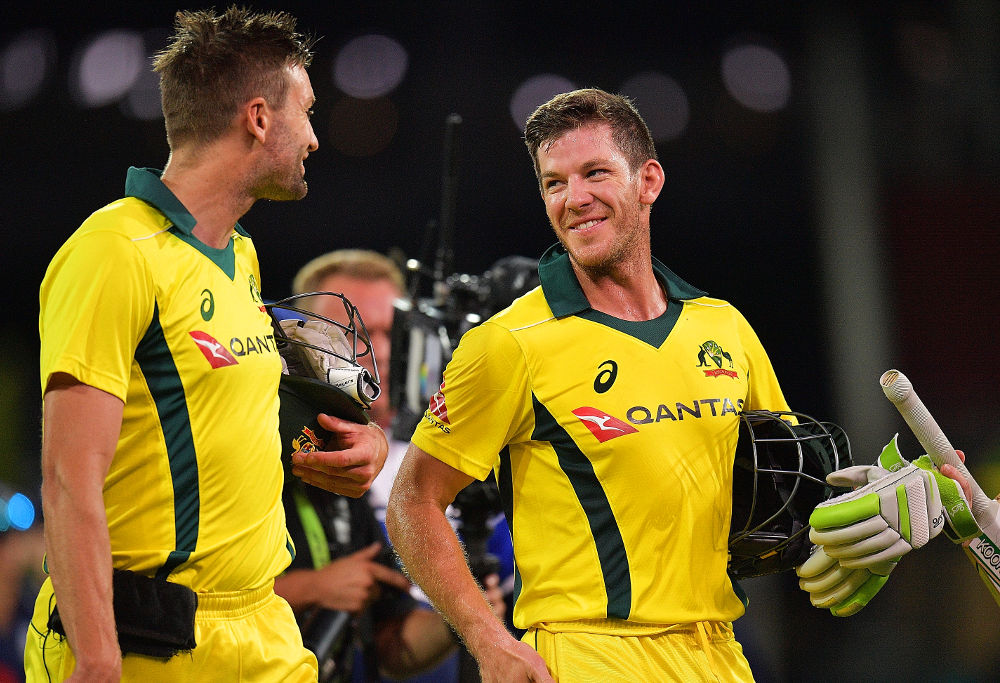Australia’s ODI wicketkeepers have batted down the order for years now, but Tim Paine’s unsuitability to batting at the death is a good reason to trial him as an opener in England this month.
Paine was recently announced as Australia’s new captain, replacing the banned Steve Smith, which makes it likely the Tasmanian will be in the starting line-up for the 2019 World Cup in 12 months from now.
If Australia are to win that tournament as outsiders, it is crucial they swiftly find the right batting role for the 33-year-old.
This month’s five-match series in England is the perfect opportunity to experiment in the same conditions the team will face at the World Cup.
Realistically, Australia are no chance of beating England this series, given they will be without six members of their best XI – Steve Smith, David Warner, Mitchell Starc, Josh Hazlewood, Pat Cummins and Mitch Marsh.
Even when they were at almost full strength, against England in January, Australia still got hammered at home by the world’s number one ODI team.
So there’s little to lose by trying out some new tactics.
Paine has done a fantastic job with the bat in Test cricket since making a shock return last summer. In the longest format he is well suited to batting at seven due to his patience and ability to operate well with the tail.

Andrew Tye and Tim Paine of Australia. (Photo by Daniel Kalisz/Getty Images)
By contrast, he lacks the dynamism required to be an effective seven in 50-over cricket, where teams routinely make huge totals off the back of scoring at ten runs per over or more during the death. Paine’s batting is built on timing and placement rather than brutality.
This is why he has spent most of his ODI and T20 careers as an opening batsman.
Against a hard, new ball, with the field up, Paine’s timing and placement come to the fore. He can lean into a drive and stroke it to the vacant cover boundary, or clip the ball off his hip through an unguarded deep square region to the fence.
Those same shots earn him only a single when batting at seven against an old ball with the field set deep. This is why batsmen in that position need to be able to manufacture boundaries with pure hitting power, muscling decent deliveries over the infield or over the fence.
That is not Paine’s game. He seems unlikely to be able to come in during the final ten overs and crunch 40 from 30 balls, the kind of sprightly innings expected of a good number seven.
This was my impression watching him in the domestic 50-over competition, and an impression which was confirmed during the January ODIs against England.
Batting at seven, Paine made scores of 27, 31*, 25* and 34 in that series. While that is a handy contribution, the downside was that not one of those knocks came at strike rate of better than 88.
His strike rate across that series was 83, which translates to a run rate of just five runs per over. That is far too slow when you consider Paine came to the crease in the final 15 overs in three out of his four knocks.
In the third match, Paine arrived to bat with Australia 5-210 with 11.3 overs remaining. They needed 93 runs to win at a manageable rate of eight runs per over.
Instead, they made just 1-76 during that period, scoring at a tardy 6.6 runs per over even though they finished with four wickets in hand. Paine ended up not out with 31 from 35 balls.
He managed just one boundary – a four – despite Australia’s need to pick up the pace.
It wasn’t for a lack of trying – Paine just didn’t have the power needed in such a circumstance. He’s unlikely to suddenly reinvent himself as a destructive strike down the order, which is why it makes sense to give Paine a crack at opening.
[latest_videos_strip category=”cricket” name=”Cricket”]
At the top of the order he has greater potential versatility. Paine could be instructed either to play an anchor role, while others attack around him, or encouraged to take on the bowlers as he does against the new ball in the Big Bash League.
The latter, aggressive approach would make more sense in the upcoming series, given the hosts’ ballistic batting power. England have no trouble setting or chasing totals of 350-plus, so Australia need to take some risks with the bat.
Paine could open the batting with ferocious striker D’Arcy Short and both go after England’s modest pace attack. If this aggression didn’t come off, the Aussies would still have three batsmen to come – Aaron Finch, Shaun Marsh and Travis Head – comfortable building an innings.
On the other hand, if Short and Paine got off to a flyer, Australia would be in a position to manipulate their batting order, potentially elevating the likes of Glenn Maxwell or Marcus Stoinis to continue the assault.
The alternative – playing Paine out of position at seven – seems folly.
Australia have nothing to lose, let the skipper open.






























































































